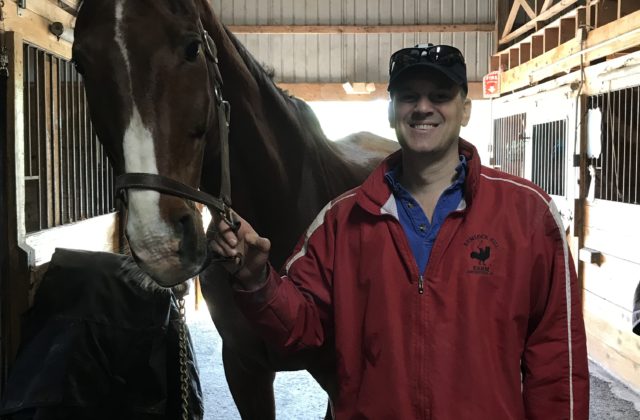Acupuncture for Horses? Of course!
Results-based alternative therapies for pets
By Kelly Kandra Hughes
Mexico, a horse with a big personality, wasn’t too sure about Dr. Andrew Flint, DVM, of Litchfield Hills Mobile Veterinary Clinic, the first time they met. Now, he greets Dr. Flint every time by sticking his head out of his stall and making all sorts of happy noises.
Dr. Flint mostly practices wellness care for dogs and cats. But he’s one of a few DVMs who has training in veterinary body work, including chiropractic care and acupuncture. This work can be done on any animal from a guinea pig to an elephant, though Dr. Flint’s bodywork patients so far have been limited to horses, cows, dogs and cats. The majority of his bodywork has been on horses, like Mexico.
Dr. Flint, who earned his DVM in 2006, got started in animal body work 11 years ago. His German Shepherd, Maia, developed cancer. Someone he knew worked for a vet that practiced Chinese herbal medicine. Maia ended up living well past her prognosis making Dr. Flint a believer in alternative healthcare therapies.
Wanting to offer alternative therapies to his own patients, Dr. Flint then completed two six-month intensive certification trainings, one through the International Veterinary Chiropractic Association and the other through the International Veterinary Acupuncture Society.
A typical chiropractic session with a horse begins with watching the horse walk, which provides a better view of their body mechanics than trotting or running. Oftentimes, a horse’s problem will be identifiable by watching how their body moves. Dr. Flint will then palpate each point on the horse’s spine starting with their hips and going up to their head. He will also adjust their ribs and legs. The sessions aren’t dramatic like a human chiropractic session—there’s no loud cracking or popping noises.
For acupuncture, Dr. Flint begins the session by palpating acupuncture points to start. The horse’s response will then give him an idea where there are issues. Dr. Flint says that if he knows a horse has a specific condition, he may start with known body points that are associated with that condition. He says this is a more Americanized way of using acupuncture than a whole-body approach.
Ask Dr. Flint what makes for a successful chiropractic or acupuncture session on a horse and he says it helps if the horse has first had massage therapy. “Everything is connected. If the muscles are loose, it’s much easier to work on the joints and vice versa.”
Kate Kennedy, a certified equine myofascial trigger point therapist who lives in Colebrook, has been massaging horses for 26 years, and she is still amazed at the wonderful results bodywork can have on them. “It’s such a joy to see the look in a horse’s eyes when they realize the pain is gone or their range of motion is restored to their neck or legs or spine.”
Kennedy recently worked with a gelding who was very sore through his withers, hind end, and poll, a point immediately behind or right between the horse’s ears. He would kick out with his hind legs trying to protect himself from Kennedy as she palpated his muscles looking for soreness and tension. The horse was so stressed by his bodily discomfort he would become explosive in his work at times. He was considered unreliable and unrideable.
Through Kennedy’s work, she helped identify Lyme disease, Magnesium and Vitamin E deficiencies, ulcers and a dental imbalance as underlying health problems. As each of these issues was resolved through veterinary care, Kennedy was able to restore muscle function and comfort. The horse is now back in training and by all reports very happy, sound and comfortable in his work.
The behaviors shown by this horse Kennedy helped are typical of an animal in pain. Other signs include mobility issues, stiffness, crooked gait and personality changes such as being mean, grouchy, or refusing to do commands previously learned. Animals showing these signs may be good candidates for bodywork. It’s important to check credentials of anyone offering alternative therapies for animals to make sure they have the proper training and education to perform these treatments.
Some people may be skeptical of these alternative treatments, especially for animal care. Dr. Flint, however, says that these therapies are highly results-based. “Animals can’t fake it. The therapies either work or they don’t. You can see the horse is stiff and not moving at the start of the session. and by the time you’re finished, the horse is moving much better.”
There’s also the compassion issue. As Kennedy says, “for many people, their horses are more than just horses. They care deeply for them and what them to be happy and comfortable.”
Photo, of Dr. Andrew Flint and Mexzico, courtesy of Andrew Flint.

